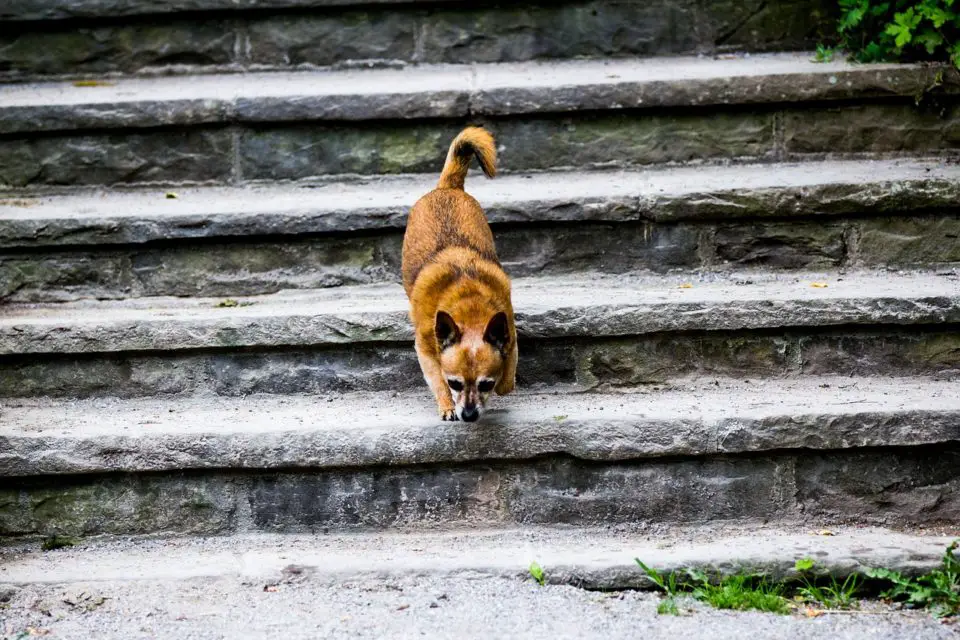Whether your house has a grand staircase, or you just have one to help your dog get on the bed, it’s important to teach your dog exactly how stairs work.
There are no stairs in the wild, so dogs don’t have the natural instinct or knowledge of how to climb them.
With that being said, your dog’s first time on the stairs may be a difficult situation. Imagine trying to go down the stairs for the very first time, but on all fours – it can be a challenging and frightening process.
This process can become even more challenging if your dog is afraid or anxious around the stairs.
If your dog has a phobia of stairs, either because of a traumatic experience or lack of exposure, it’s important that you help them gain the confidence to go up and down them.
Dogs and Stairs
Why is Your Dog Afraid?

Dogs are afraid for taking the stairs for a lot of reasons. The main two causes of this phobia, though, are trauma and lack of early exposure.
If your dog falls down the stairs or obtains an injury while he or she is on the stairs, they may come to associate the steps with that negative, painful feeling, and that is what leads to a phobia.
On the other hand, if your dog was not exposed to the stairs as a puppy, he or she may not know exactly what they are or how they work.
This, due to dogs’ natural fear of the unknown, can manifest in a lack of confidence that prevents your dog from taking the stairs.
Thankfully, in both of these situations, you can help your dog overcome this fear – and that is the first step to teaching your dog how to overcome them.
How Can You Remove that Fear?
Dogs, in a sense, are a lot like humans. After constant safe and positive encounters with their fear, it can usually be overcome.
Before you can even teach your dog how to use the stairs, if they have a fear, you need to help them gain their confidence.
Thankfully, this is a fairly easy process. All you have to do is help your dog associate stairs with safety. Try sitting beside them on the staircase or distracting them with a treat.
Try to limit sharp movements or loud noises. If your dog like music, you can even try playing them a dog friendly relaxation video to help ease their mind.
Eventually, they won’t shy away from the steps, and then you can begin teaching them how to climb up and down the stairs.
How to Teach Your Dog to Climb Stairs
Upstairs
Teaching your dog to go up the stairs is the easy part, so that’s a good place to begin to help your dog understand how the stairs work while building confidence.
Set your dog up properly on the stairs with their fore paws on one step and their back paws on the lower step.
Make sure that you stand directly behind them and use a leash with constant pressure to guide them while providing the assurance that they won’t fall.
This is especially comforting for a dog that is already anxious or has had bad experiences with falling down the stairs.
 Once you and your dog are in the right positions, you can offer them a treat to help them relax. Place the food on the steps, and do not try to force them to eat – this will only further stress them.
Once you and your dog are in the right positions, you can offer them a treat to help them relax. Place the food on the steps, and do not try to force them to eat – this will only further stress them.
If possible, have someone at the top of the steps to call them. While they are being called, make sure you keep a constant pressure on the leash.
This will encourage them to walk rather than jump up the stairs. If you don’t have someone to call them, walk slowly up the stairs – with your back to your dog – and encourage them to follow.
Do not jerk or drag them up the stairs, as this will establish that stairs are negative or painful.
Once they reach the top of the stairs, reward them and carry them back down to the bottom to try again.
Downstairs
Once you have taught your dog to go up the stairs, teaching them down will be easy. Not only will they now be comfortable on the stairs, but the process is nearly the same!
Start closer to the bottom – about two or three steps up – and encourage your dog to walk down them the same way. Make sure to keep a constant pressure on their leash and use food as an encouragement.
As your dog succeeds, start them higher and higher up until they are eventually ready to walk down the entire staircase.
Condensed Process
If you’re anything like me, you might struggle to get the best results without a solid, step by step plan.
While knowing what and what not to do is always helpful, sometimes, the very best help is a clear, concise plan. If that sounds like the kind of thing you need, here is the step by step plan:
- Put a leash on your dog and place them properly on the steps while standing behind them
- Offer them treats and verbal praise until they are relaxed
- If you have someone to help you, have them call your dog while you gently guide them and encourage them up the stairs
- If you are alone, step around your dog and walk up the stairs normally, gently leading and encouraging them to follow.
- Once at the top of the stairs, reward your dog
- Repeat a few more times
- Do the same for going down the steps
Treat Ideas for Stair Training
 It’s important when you’re training your dog to go up and down the stairs that you pair positive verbal encourage with treats.
It’s important when you’re training your dog to go up and down the stairs that you pair positive verbal encourage with treats.
When you are treating your dog, place the food on the steps rather than your hand, and do not force your dog to eat the food if they do not want it. By using food, you will help establish the idea that the stairs are good.
While you can use normal dog training treats, this is a special occasion in which human food can work too. Try different treats such as ham, turkey, bacon, or cheese.
Make sure the pieces are small and be careful not to over treat your dog. That last thing you want to do when rewarding your dog is expose them to potential health issues like diabetes or obesity.
Brain Training
Another interesting way to improve your dogs abilities is, brain training. Dogs are highly intelligent animals, and, with just a little work, you can help them fully utilize that intelligence.
Instead of the traditional pack-style training – which focuses on dominance and can be harsh – brain training uses a science-based approach to help your dog focus.
The principles that Brain Training for Dogs in based on, stem from research conducted by Ivan Pavlov.
Brain training uses games and activities that are fun for both you and your dog to help them unlock that hidden intelligence which can be used during staircase training.
When to Seek Professional Help
Sometimes, no matter how many times you try, your dog just won’t be able to do climb up or down the stairs.
This doesn’t mean that you have to move to a house without stairs or carry your dog everywhere, though. Much like for any other trick, you can always seek a professional for help.
If your dog, even after constant and positive exposure, is still acting anxious around and on the stairs, or if they are struggling to climb them properly after hours of training, then you make want to consider seeking out a professional dog trainer.
A professional dog trainer will be able to properly train your dog without causing any fear – and usually for a reasonable price. You can use this website to find a trainer near you, along with local reviews.
Final Thoughts
 Teaching your dog to climb up and down the stairs is an important and valuable task that, while a little challenging, you won’t regret.
Teaching your dog to climb up and down the stairs is an important and valuable task that, while a little challenging, you won’t regret.
If you have stairs of any height in your home, teaching your dog to climb them will allow them to connect with you more while preventing any future injuries.
There are a lot of different ways to train your dog to climb the stairs, and, if your dog is already fearful of the steps, you might have to start with helping them gain confidence.
Despite this, your dog will appreciate you helping them to be comfortable and confident in their own home.

